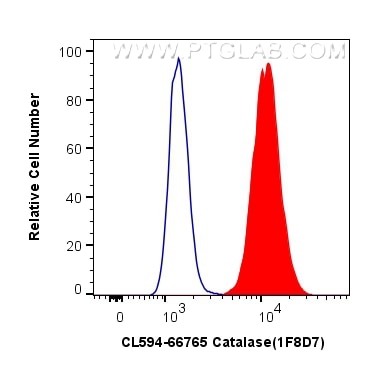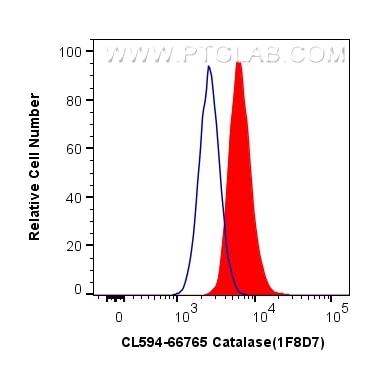CoraLite®594-conjugated Catalase Monoclonal antibody
Catalase Monoclonal Antibody for FC (Intra)
Host / Isotype
Mouse / IgG1
Reactivity
Human, Mouse, Rat, Pig
Applications
FC (Intra)
Conjugate
CoraLite®594 Fluorescent Dye
CloneNo.
1F8D7
Cat no : CL594-66765
Synonyms
Validation Data Gallery
Tested Applications
| Positive FC detected in | HepG2 cells |
Recommended dilution
| Application | Dilution |
|---|---|
| Flow Cytometry (FC) | FC : 0.40 ug per 10^6 cells in a 100 µl suspension |
| Sample-dependent, check data in validation data gallery | |
Product Information
CL594-66765 targets Catalase in FC (Intra) applications and shows reactivity with Human, Mouse, Rat, Pig samples.
| Tested Reactivity | Human, Mouse, Rat, Pig |
| Host / Isotype | Mouse / IgG1 |
| Class | Monoclonal |
| Type | Antibody |
| Immunogen | Catalase fusion protein Ag16916 相同性解析による交差性が予測される生物種 |
| Full Name | catalase |
| Calculated molecular weight | 60 kDa |
| Observed molecular weight | 60 kDa |
| GenBank accession number | BC112219 |
| Gene symbol | CAT |
| Gene ID (NCBI) | 847 |
| Conjugate | CoraLite®594 Fluorescent Dye |
| Excitation/Emission maxima wavelengths | 588 nm / 604 nm |
| Form | Liquid |
| Purification Method | Protein G purification |
| Storage Buffer | PBS with 50% Glycerol, 0.05% Proclin300, 0.5% BSA, pH 7.3. |
| Storage Conditions | Store at -20°C. Avoid exposure to light. Stable for one year after shipment. Aliquoting is unnecessary for -20oC storage. |
Background Information
Catalase belongs to the catalase family. CAT occurs in almost all aerobically respiring organisms and serves to protect cells from the toxic effects of hydrogen peroxide. CAT promotes growth of cells including T-cells, B-cells, myeloid leukemia cells, melanoma cells, mastocytoma cells and normal and transformed fibroblast cells. CAT catalyzes the reaction: 2 H2O2 = O2 + 2 H2O. Defects in CAT are the cause of acatalasia (ACATLAS) which also known as acatalasemia.
Protocols
| Product Specific Protocols | |
|---|---|
| FC protocol for CL594 Catalase antibody CL594-66765 | Download protocol |
| Standard Protocols | |
|---|---|
| Click here to view our Standard Protocols |



